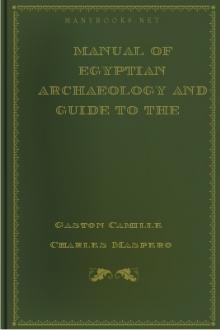Ancient America, in Notes on American Archaeology by John D. Baldwin (best thriller books to read .TXT) 📕

"It is in the form of a serpent, upward of 1000 feet in length, extended i
Read free book «Ancient America, in Notes on American Archaeology by John D. Baldwin (best thriller books to read .TXT) 📕» - read online or download for free at americanlibrarybooks.com
- Author: John D. Baldwin
- Performer: -
Read book online «Ancient America, in Notes on American Archaeology by John D. Baldwin (best thriller books to read .TXT) 📕». Author - John D. Baldwin
This ancient race seems to have occupied nearly the whole basin of the Mississippi and its tributaries, with the fertile plains along the Gulf, and their settlements were continued across the Rio Grande into Mexico; but toward their eastern, northern, and western limit the population was evidently smaller, and their occupation of the territory less complete than in the Valley of the Ohio, and from that point down to the Gulf. No other united people previous to our time can be supposed to have occupied so large an extent of territory in this part of North America.
It has heretofore been stated that remains of this people exist in Western New York, but a more intelligent and careful examination shows that the works in Western New York are not remains of the Mound-Builders. This is now the opinion of Mr. Squier, formed on personal investigation since the great work of Squier and Davis was published.
THEIR CIVILIZATION.It is usual to rank the civilized life of the Mound-Builders much below that of the ancient people of Mexico and Central America. This may be correct, for the remains as they now exist appear to justify it. But if all the ancient stone-work in Central America, with its finely-carved inscriptions and wonderful decorations, had disappeared in the ages before Europeans visited this continent, the difference might not appear to be so great; for then the Central American remains, consisting only of earth-works, truncated pyramids, pyramidal foundations, and their connected works made of earth, would have a closer resemblance to works of the Mound-Builders, to those especially found on the lower Mississippi. On the other hand, if we now had in the Ohio and Mississippi Valleys remains of the more important edifices anciently constructed there, the Mound-Builders might be placed considerably higher in the scale of civilization than it has been customary to allow.
It can be seen, without long study of their works as we know them, that the Mound-Builders had a certain degree of civilization which raised them far above the condition of savages. To make such works possible under any circumstances, there must be settled life, with its accumulations and intelligently organized industry. Fixed habits of useful work, directed by intelligence, are what barbarous tribes lack most of all. A profound change in this respect is indispensable to the beginning of civilization in such tribes.
No savage tribe found here by Europeans could have undertaken such constructions as those of the Mound-Builders. The wild Indians found in North America lived rudely in tribes. They had only such organization as was required by their nomadic habits, and their methods of hunting and fighting. These barbarous Indians gave no sign of being capable of the systematic application to useful industry which promotes intelligence, elevates the condition of life, accumulates wealth, and undertakes great works. This condition of industry, of which the worn and decayed works of the Mound-Builders are unmistakable monuments, means civilization.
Albert Gallatin, who gave considerable attention to their remains, thought their works indicated not only “a dense agricultural population,” but also a state of society essentially different from that of the Iroquois and Algonquin Indians. He was sure that the people who established such settlements and built such works must have been “eminently agricultural.” No trace of their ordinary dwellings is left. These must have been constructed of perishable materials, which went to dust long before great forests had again covered most of the regions through which they were scattered. Doubtless their dwellings and other edifices were made of wood, and they must have been numerous. It is abundantly evident that there were large towns at such places as Newark, Circleville, and Marietta, in Ohio. Figures 11 and 12 give views of works on Paint Creek, Ohio.
Their agricultural products may have been similar to many of those found in Mexico; and it is not improbable that the barbarous Indians, who afterward occupied the country, learned from them the cultivation of maize. Their unity as a people, which is every where so manifest, must have been expressed in political organization, else it could not have been maintained.
In the details of their works, and in manufactured articles taken from the mounds, there is evidence of considerable civilization. For instance, it has been ascertained that the circular inclosures are perfect circles, and the square inclosures perfect squares. They were constructed with a geometrical precision which implies a kind of knowledge in the builders that may be called scientific. Figures 13, 14, 15, 16 show some of the more important works of the Mound-Builders, chiefly in Ohio. Relics of art have been dug from some of the mounds, consisting of a considerable variety of ornaments and implements, made of copper, silver, obsidian, porphyry, and greenstone, finely wrought. There are axes, single and double; adzes, chisels, drills or gravers, lance-heads, knives, bracelets, pendants, beads, and the like, made of copper. There are articles of pottery, elegantly designed and finished; ornaments made of silver, bone, mica from the Alleghanies, and shells from the Gulf of Mexico.
The articles made of stone show fine workmanship; some of them are elaborately carved. Tools of some very hard material must have been required to work the porphyry in this manner. Obsidian is a volcanic product largely used by the ancient Mexicans and Peruvians for arms and cutting instruments. It is found in its natural state nowhere nearer the Mississippi Valley than the Mexican mountains of Cerro Gordo.
There appears to be evidence that the Mound-Builders had the art of spinning and weaving, for cloth has been found among their remains. At the meeting of the International Congress of Pre-Historic Archæology held at Norwich, England, in 1868, one of the speakers stated this fact as follows: “Fragments of charred cloth made of spun fibres have been found in the mounds. A specimen of such cloth, taken from a mound in Butler County, Ohio, is in Blackmore Museum, Salisbury. In the same collection are several lumps of burnt clay which formed part of the ‘altar,’ so called, in a mound in Ross County, Ohio: to this clay a few charred threads are still attached.” Figures 17 and 18 represent specimens of vases taken from the mounds.
Mr. Schoolcraft gives this account of a discovery made in West Virginia: “Antique tube: telescopic device. In the course of excavations made in 1842 in the easternmost of the three mounds of the Elizabethtown group, several tubes of stone were disclosed, the precise object of which has been the subject of various opinions. The longest measured twelve inches, the shortest eight. Three of them were carved out of steatite, being skillfully cut and polished. The diameter of the tube externally was one inch and four tenths; the bore, eight tenths of an inch. This calibre was continued till within three eighths of an inch of the sight end, when it diminishes to two tenths of an inch. By placing the eye at the diminished end, the extraneous light is shut from the pupil, and distant objects are more clearly discerned.”
He points out that the carving and workmanship generally are very superior to Indian pipe carvings, and adds, if this article was a work of the Mound-Builders “intended for a telescopic tube, it is a most interesting relic.” An ancient Peruvian relic, found a few years since, shows the figure of a man wrought in silver, in the act of studying the heavens through such a tube. Similar tubes have been found among relics of the Mound-Builders in Ohio and elsewhere. In Mexico, Captain Dupaix saw sculptured on a peculiar stone structure the figure of a man making use of one. Astronomical devices were sculptured below the figure. This structure he supposed to have been used for observation of the stars. His account of it will be given in the chapter on Mexican and Central American ruins.
The Mound-Builders used large quantities of copper such as that taken from the copper beds on Lake Superior, where the extensive mines yield copper, not in the ore, but as pure metal. It exists in those beds in immense masses, in small veins, and in separated lumps of various sizes. The Mound-Builders worked this copper without smelting it. Spots of pure silver are frequently found studding the surface of Lake Superior copper, and appearing as if welded to it, but not alloyed with it. No other copper has this peculiarity; but copper with similar blotches of silver has been dug from the mounds. It was naturally inferred from this fact that the ancient people represented by these antiquities had some knowledge of the art of mining copper which had been used in the copper region of Lake Superior. This inference finally became an ascertained fact.
THEIR ANCIENT MINING WORKS.Remains of their mining works were first discovered in 1848 by Mr. S. O. Knapp, agent of the Minnesota Mining Company, and in 1849 they were described by Dr. Charles T. Jackson, in his geological report to the national government. Those described were found at the Minnesota mine, in upper Michigan, near Lake Superior. Their mining was chiefly surface work; that is to say, they worked the surface of the veins in open pits and trenches. At the Minnesota mine, the greatest depth of their excavations was thirty feet; and here, “not far below the bottom of a trough-like cavity, among a mass of leaves, sticks, and water, Mr. Knapp discovered a detached mass of copper weighing nearly six tons. It lay upon a cob-work of round logs or skids six or eight inches in diameter, the ends of which showed plainly the marks of a small axe or cutting tool about two and a half inches wide. They soon shriveled and decayed when exposed to the air. The mass of copper had been raised several feet, along the foot of the lode, on timbers, by means of wedges.” At this place was found a stone maul weighing thirty-six pounds, and also a copper maul or sledge weighing twenty-five pounds. Old trees showing 395 rings of annual growth stood in the débris, and “the fallen and decayed trunks of trees of a former generation were seen lying across the pits.” Figure 19 (opposite) presents a section of this mining shaft of the Mound-Builders: a shows the





Comments (0)